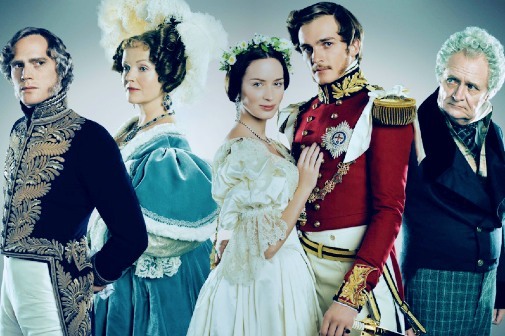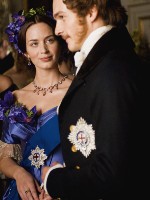by Cláudio Alves

It's difficult to follow the Oscar race each year without developing a prejudice against prestige biopics. At times it seems its the genre where creativity goes to die, where formulas thrive and the appearance of respectability is more important than genuine artistic merit. These words are perchance, too harsh, because specific qualities do manage to shine through the baseline of expected mediocrity on numerous occassions. Take The Young Victoria, Jean-Marc Vallée's perfectly serviceable retelling of Queen Victoria's early years and marriage to Prince Albert. Rewatching it ten years after its initial release, the film isn't as despairingly dry as you may have remembered. The Young Victoria is one of Emily Blunt's lesser efforts, but she's luminous nonetheless, bringing a sense of modernity that rubs abrasively against the historical setting. She never convinces as a 19th-century ruler, but that manages to feel more like a feature than a fault. As for Rupert Friend's Albert, he remains a charming romantic ideal, establishing great chemistry with Blunt.
And then, of course, there are Sandy Powell's Oscar-winning costumes…
Of her three wins in the category, this is Powell's least deserving victory and, judging by her words, one imagines the designer feels the same. Her humbleness and biting wit, her criticism of the Academy's love for extravagant costume dramas in detriment of subtle or less moneyed contemporary work make this one of the best speeches the category ever produced. It proves once again that Powell is one of the great champions of her profession.
 Still, it'd be terribly uncouth to celebrate the film's 10th anniversary with an eyeroll and morsels of faint praise. The Young Victoria's designs are only minor when compared to the rest of Powell's filmography, offering a balanced cocktail of historical fidelity and stylization that represents a nice match to Blunt's anachronistic presence. The 1830s represent one of the wackiest periods of European fashion. It's no easy feat to make high-waisted dresses with leg of mutton sleeves and bell-shaped skirts seem attractive to contemporary viewers.
Still, it'd be terribly uncouth to celebrate the film's 10th anniversary with an eyeroll and morsels of faint praise. The Young Victoria's designs are only minor when compared to the rest of Powell's filmography, offering a balanced cocktail of historical fidelity and stylization that represents a nice match to Blunt's anachronistic presence. The 1830s represent one of the wackiest periods of European fashion. It's no easy feat to make high-waisted dresses with leg of mutton sleeves and bell-shaped skirts seem attractive to contemporary viewers.
The Young Victoria's narrative spans from 1837 to 1840 and Sandy Powell used the changing fashions of the Romantic and Victorian eras to delineate her character's evolution. Regarding Victoria herself, the clothes paint a picture of a sheltered girl transitioning to adulthood, from doll-like confections to more sleek and womanly silhouettes. To do that, Powell pulled from the styles of the later decade for the second half of the film, dressing Blunt in outfits that have more to do with 1845 than 1840. This highlights her as a character that's always ahead of her time as well as someone that's slightly out of step with the women of her life, be it her tyrannical mother or her smothering ladies-in-waiting.
These design choices offer a parallel story complementing and augmenting the film's text. Powell does similar things with color and textiles, using shades that would be impossible before the commercialization of aniline dyes and machine embroidered patterns to brighten up the story and underline the protagonist's arc. Emily Blunt may start the film in buttery yellows and baby blues, but she finishes it in jewel tones befitting a queen. When doing period work, it's never just about copying historical images or doing empty spectacle. I might not like The Young Victoria very much, but it'd be false to say its Oscar victory is completely undeserved.
That said, it'd be nice to see some excellent contemporary costume design recognized once in a while. Taking a cue from Powell's acceptance speech, here are five examples that would have been deserving nominees in 2009. The Academy would never consider these kinds of achievements, but the category would be perpetually richer if they did.
 Bina Daigeler's eccentric designs for The Limits of Control are a bizarre delight.
Bina Daigeler's eccentric designs for The Limits of Control are a bizarre delight.
 Sonia Grande's glamourous reveries in Broken Embraces turn Penélope Cruz into a dream of cinematic perfection.
Sonia Grande's glamourous reveries in Broken Embraces turn Penélope Cruz into a dream of cinematic perfection.
 Hope Hanafin weaponizes and deconstructs quirkiness in (500) days of Summer.
Hope Hanafin weaponizes and deconstructs quirkiness in (500) days of Summer.
 April Napier echoes Cassavete's Gloria with her character-specific designs in Julia.
April Napier echoes Cassavete's Gloria with her character-specific designs in Julia.
 Catherine Marie Thomas makes delirious comedy out of clothing with her designs for Whip It.
Catherine Marie Thomas makes delirious comedy out of clothing with her designs for Whip It.
Would you have nominated any of these?
